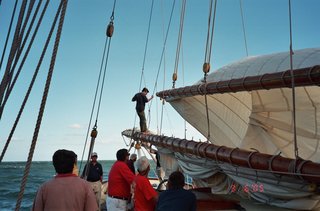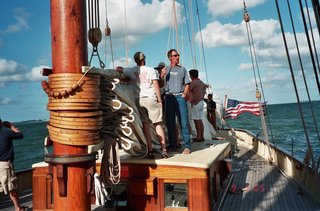Not Exactly FBYC History
Jere Dennison

Your Historian was blessed to be included in a mostly FBYC guest crew to deliver the 122 schooner Virginia from Deltaville - where she had been on station in Fishing Bay during our Stingray Point Regatta - to Richmond over a two and a half day period following Labor Day. Our host was Brent Halsey, FBYC member and Trustee of the Marine Heritage Foundation that owns and operates the Virginia . Besides Brent and me, the other guest crewmembers were: Jamie Meyer, Winston Williams, Preston Smith, Parke Smith, Kenny Sailor, Doug Dorsey, John Halsey, Matt Braun, Dabney Overton, and Chip Hall. Brent had initially invited members of his former racing crew aboard for the voyage, but two, Chip Hall and myself, were the beneficiaries of late cancellations by two of the original crew. (Chip received a truly last minute invitation when his morning shower was interrupted by an urgent call just 15 minutes prior to the scheduled departure at 0900 Tuesday morning.)
Upon boarding the schooner, we were read the Articles of War which governed crew behavior (always back down the companionway steps; remove your hat at meals; follow safety procedures; no grog until the anchors down; etc.) by the extraordinarily competent First Mate Dana, introduced to the permanent crew, and then invited to pick our bunks in the main cabin. There are a total of 12 commodious bunks; six on each side stacked two high. (If one is astute, he is able to claim one of the coveted top bunks that are slightly larger than the bottom versions due to the outward flair of the hull with an opening port for a ventilated view.) Each bunk has a privacy curtain for modesty protection and sound reduction.
Commanding the center of the passenger cabin is a large mess table with a long bench astride each side. All meals prepared by Chef Keith will be consumed here. The galley, two heads, and the permanent crew quarters are located forward. Aft are the engine room, pilothouse with state-of-the-art electronics, and Captains cabin. The engine room accommodates two 205 HP diesel engines. But what really gets your attention below is the delicious aroma produced by the wood used in constructing the hull and its gleaming interior.

We were lucky with the weather for the first days run to Newport News. The late-summer cold front that had dominated the Stingray Point Regatta weekend with blustery winds continued into Tuesday with 20 to 25 knots from the northeast under fair skies. One word can describe these conditions for the fair-hulled Virginia : PERFECT! Off Cherry Point, all hands assisted in raising the huge gaff-rigged mainsail and foresail huffing and puffing without the benefit of winches just like in the olden days. The jib and staysail were set and we were off and screaming downwind on a broad reach at 9.5 to 10 knots with a bone in our teeth. Even with high Chesapeake following seas, the Virginias wood deck felt as stable underfoot as the deck of the Queen Mary. Had she been fitted with her full complement of sails that would have added a main topsail, fore topsail, and jib topsail to her sail area, there is no doubt that Virginia could have achieved her theoretical hull speed of almost 12 knots.

As we neared Hampton Roads in the mid-afternoon, Captain Nicholas Alley had a decision to make. He had never jibed the Virginia in these windy conditions and was contemplating a chicken jibe by wearing ship to avoid any chance of damage to the rig. Persuaded by the crews insistence, we would jibe. Jibing a schooner of 157 tons displacement with gyrating telephone poles for booms and gaffs is a serious maneuver anytime, but especially in heavy air. The first order of business is to trim the headsails, then the foresail, and finally the mainsail tight amidships. Then throw over the helm and pray her stern turns through the wind. Excruciatingly Virginia began to rotate westward toward Fort Monroe. Finally we were able to ease the sheets on starboard tack, and the schooner blasted up the lower James to an overnight anchorage in the shadow of Newport News Shipbuilding for dining and carousing about the decks until late into the evening.
The next morning we awoke early to scrub the decks, weigh the 500-pound fisherman anchor (mercifully accomplished with an electric windlass), and get underway for an 0800 opening of the James River Bridge during rush hour. With a mast height over 110 and a 60vertical bridge clearance in its lowered position, the skipper had booked the opening in advance. Long lines of vehicles filled with frustrated commuters congested the lanes on each side of the bridge as the Virginia meandered under the raised span. But what a beautiful sight they must have had to compensate them for the inconvenience they were suffering.

Clearing the bridge, it was clear that our sailing experience was over. The winds had lightened and became contrary. We would motor the final two legs of the trip up the James. Still gorgeous weather, we viewed the Ghost Fleet near Jamestown and climbed the ratlines. Later, as we approached the Benjamin Harrison Bridge at Hopewell, a speedboat altered course to hail the Virginia . It was captained by a male with two shapely females as cargo. As they sped by waving, the crew returned their gestures with gusto. Thereupon the bikini-clad females acknowledged our enthusiasm with, umm, a special salute revealing certain non-sunburned portions of their torsos.
Awhile later in the afternoon we anchored in a narrow offshoot of the James near Curles Neck in water that was barely deeper at low tide than our 12 draft. As the day had grown hot, some swam and drank adult beverages. A sun awning was hoisted over the foresail boom, and we awaited the coolness of the evening. The last dinner aboard was punctuated with several toasts, many thanking Brent for making our memorable trip possible. In a more solemn toast, Brent expressed his gratitude to Parke Smith, on leave from duty in Iraq with the Marine Corp, for his service to our country. This was a poignant moment for all of us since we knew Parke would be returning to the war zone next spring after some additional training.

The final half-day of the voyage was non-eventful as we snaked our way up the narrowing waterway to Intermediate Terminal in the shadow of Richmonds Church Hill. The highlight of this leg was passing Jimmy Deans manse on the James with his monogrammed lawn. No public tours for Virginia were scheduled, and hence no large welcoming throng greeted us at the end of our journey to the Capitol City. Although tours were initially contemplated, the Virginia was not yet equipped with a proper gangway to allow safe public access to the vessel from the concrete bulkhead that towered over our deck at the terminal. Ascending an aluminum house ladder to disembark in downtown Richmond was an anticlimactic end to a fabulous trip.
You too can experience the shipboard delights of an early 20th century schooner. The Virginia is scheduling each year a number of cruises around the Chesapeake Bay. Check out www.schoonervirginia.org for available dates and the modest fees for an unforgettable trip.
You can see all of Jere's pictures at Flickr Slide Show